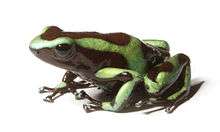Green and black poison dart frog
| Dendrobates auratus | |
|---|---|
 | |
| D. auratus from Panama | |
| Scientific classification | |
| Kingdom: | Animalia |
| Phylum: | Chordata |
| Class: | Amphibia |
| Order: | Anura |
| Suborder: | Neobatrachia |
| Family: | Dendrobatidae |
| Genus: | Dendrobates |
| Species: | D. auratus |
| Binomial name | |
| Dendrobates auratus (Girard, 1855) | |
 | |
| Range in red (Hawaiian population introduced) | |
Dendrobates auratus, also known as the green and black poison dart frog or the green and black poison arrow frog, and sometimes mint poison frog (not to be confused with the mint-green color morph of Phyllobates terribilis), is a brightly colored member of the order Anura native to Central America and northwestern parts of South America. This species has also been introduced to Hawaii.[1] It is one of the most variable of all poison dart frogs next to Dendrobates tinctorius and some Oophaga spp. It is considered to be of least concern from a conservation standpoint by the International Union for Conservation of Nature (IUCN).
Poison

The green-and-black poison frog, while not the most toxic poison dart frog, is still a highly toxic animal. The very small amount of poison the frog possesses is still enough to make a human heart stop beating. Like most poison dart frogs, however, the green-and-black poison dart frog will only release its poison if it feels that it is threatened, and wild specimens can be handled if the human holding it is calm and relaxed. The green-and-black poison frog, as with all poison dart frogs, loses its toxicity in captivity due to a change in diet. This has led scientists to believe that the green-and-black poison frog actually takes its poison from the mites it feeds on.[2]
Description
The mint poison frog is in all ways an average poison dart frog. Males reach about 0.75 inch long; females are slightly larger, up to an inch long or bigger. As the common name "mint poison dart frog" suggests, the green-and-black poison frog typically has mint-green coloration; however, they can also be forest, lime, emerald green, turquoise, pale yellow, or even cobalt blue. Many also have splotches of dark colors, ranging from wood brown to black. The green-and-black poison frog is one of the most variable of all poison frogs in appearance. Some have black or brown splotches, others are dappled, or have "splashes" of black, like Oophaga sylvaticus.
D. auratus is semiarboreal, hunting, courting, and sleeping in the trees, but as it is a small frog, it cannot jump far enough to span the distances between trees, so it returns to the ground to travel. To assist in climbing, the mint poison dart frog has small, sucker-like discs on the ends of its toes, which create a slight suction as the frogs climb, making their grip mildly adhesive (although some individuals do have difficulty climbing).
Reproduction
Like all poison dart frogs, green-and-black poison dart frogs gather in large groups before mating. They squabble over territories; eventually each individual male frog clears a small patch for himself. Females wander among the males, the latter then attempt to impress the former with their bird-like mating calls. Once a male has caught the attention of a female, he leads her to a site he has selected for egg deposition. The female lays her eggs, which he then fertilizes. In approximately 14 days, these hatch into tadpoles.[3] Their parents (typically the male) then carry the tadpoles into the canopy, with the tadpoles sticking to the mucus on their parents' backs. The parents then deposit their tadpoles into the small pools of water that accumulate in the center of bromeliads, and guard the tadpoles while they feed on algae and small invertebrates that inhabit the tiny pool.
As pets
Green-and-black poison dart frogs are popular exotic pets due to their small size, bright colors, and intriguing behavior. As with all frogs, they have permeable skin and should not be handled whenever possible. If it is imperative to move them, handling should be done with extreme care and with clean hands. Their small size makes them fearful of animals much larger than themselves, such as humans, and will attempt to escape if handled. To prevent escape, many frog keepers move their amphibians in fine-meshed nets or with cupped hands. A partly terrestrial, partly arboreal enclosure should also be provided. Poison dart frogs may be small, but is very active and needs a suitably large terrarium (usually 100 x 60 x 60 centimeters) with a high level of humidity. Live plants should also be added to provide hiding places, and bromeliads in the event the frogs breed.

References
- ↑ http://nas.er.usgs.gov/queries/factsheet.aspx?SpeciesID=49
- ↑ http://news.nationalgeographic.com/news/2007/05/070514-poison-frogs.html
- ↑ Sihler, A., Sihler, G. Poison Dart Frogs (Complete Herp Care).TFH Publications. 2007. ISBN 978-0-7938-2893-7.
- Frank Solís, Roberto Ibáñez, César Jaramillo, Gerardo Chaves, Jay Savage, Gunther Köhler, Karl-Heinz Jungfer, Wilmar Bolívar, Federico Bolaños (2008). Dendrobates auratus. In: IUCN 2008. IUCN Red List of Threatened Species. Retrieved 22 February 2009. Database entry includes a range map and justification for why this species is of least concern
External links
| Wikimedia Commons has media related to Dendrobates auratus. |
